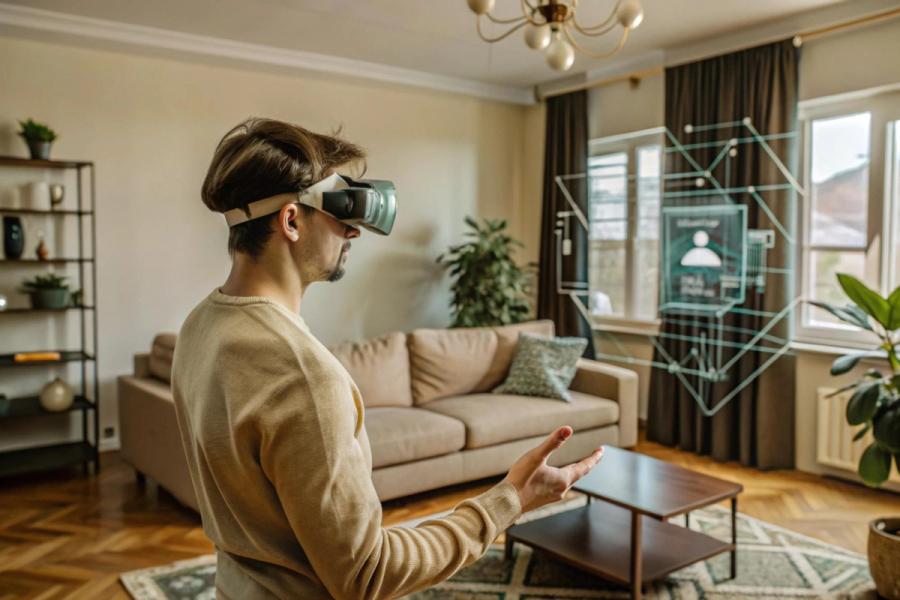Augmented Reality (AR) and Virtual Reality (VR) have already made waves across various industries, from gaming to healthcare. But as we approach 2025, the technology is set to evolve in ways that will redefine how we interact with the digital world. In this blog, we’ll explore the exciting AR/VR trends we can expect to see in 2025 and beyond, highlighting innovations that will shape consumer experiences and transform industries.
1. Immersive Shopping Experiences
As e-commerce continues to dominate, augmented reality in 2025 will take online shopping to new heights. AR technology will enable customers to try on clothes virtually, visualize furniture in their homes, and even test out makeup with real-time, 3D simulations. This will create a more engaging and personalized shopping experience, reducing the need for physical stores while improving customer satisfaction and conversion rates. Expect more retailers to integrate AR-powered apps that allow customers to make smarter, more confident purchasing decisions.
Key AR trend in 2025: The integration of AR in e-commerce platforms will transform how brands connect with consumers, leading to a seamless blend of physical and digital shopping.
2. Advancements in Virtual Reality
The future of VR innovations is poised to revolutionize industries beyond gaming. By 2025, VR will be a cornerstone of training programs, enabling highly immersive simulations for professions like medicine, aviation, and manufacturing. Virtual reality will offer real-time, hands-on experience without the need for real-world risks, making it ideal for skills training and education.
For instance, medical students will be able to practice surgery in virtual environments before performing on real patients. Similarly, pilots can use VR simulators to refine their skills without the need for costly, real-world flight hours. The potential of VR to transform education and training will only continue to grow in the coming years.
Key VR innovation in 2025: The shift from basic VR experiences to complex, real-time, fully immersive simulations will redefine how we learn and train in professional fields.
3. Extended Reality (XR) and the Metaverse
In 2025, the concept of the metaverse is expected to evolve beyond its current vision. By combining VR, AR, and mixed reality (MR) into extended reality (XR), the metaverse will provide users with a fully immersive, interconnected digital universe. This will allow people to socialize, work, play, and create in ways never before possible.
As industries continue to invest in XR technologies, businesses will begin adopting virtual offices, offering employees the ability to collaborate and engage in immersive work environments. With the rise of XR, the future of work will be redefined, allowing businesses to operate globally without the constraints of physical space.
Key XR trend in 2025: The emergence of fully immersive virtual worlds will change the way people interact with both their work and personal lives, creating new opportunities for remote work and collaboration.
4. AR/VR for Mental Health and Wellness
In the future, AR and VR will play a crucial role in mental health and wellness. By 2025, VR therapies will become more mainstream, helping individuals with anxiety, PTSD, and other mental health conditions through controlled, virtual environments that allow for therapeutic interventions. VR meditation experiences will become more advanced, providing users with fully immersive settings that aid in relaxation and mindfulness.
Moreover, AR will be used to provide real-time feedback on emotional well-being. Devices could analyze a person’s emotional state and provide recommendations for activities that improve mental health, such as guided breathing exercises or virtual relaxation environments.
Key AR/VR trend in 2025: VR and AR will provide new therapeutic avenues for mental health care, offering people personalized, immersive experiences for better mental well-being.
5. AR for Real-Time Navigation and Assistance
AR technology in 2025 will significantly enhance navigation, not just for driving but also in pedestrian contexts. With AR glasses and smart lenses, users will receive real-time, interactive directions as they move through city streets or large venues like airports, shopping malls, and stadiums. This technology will make getting from point A to point B more intuitive, with augmented overlays showing arrows, distances, and even nearby places of interest.
For businesses, AR navigation will revolutionize how customers experience physical spaces. For instance, museums could use AR to offer additional context about exhibits, while airports can help travelers find gates, baggage claim, and amenities without relying on static maps or signs.
Key AR trend in 2025: AR-powered real-time navigation will become ubiquitous, offering greater convenience and reducing stress in busy environments.
6. The Evolution of AR/VR Hardware
To fully embrace AR and VR trends in 2025, we’ll see significant advancements in hardware. AR glasses will become sleeker, lighter, and more powerful, providing an unobtrusive way to interact with the world through augmented overlays. VR headsets will evolve to deliver higher resolution, improved comfort, and greater immersion, making them more accessible to consumers across various sectors.
Additionally, advancements in haptic feedback technology will make AR/VR experiences even more immersive. The ability to “feel” virtual objects and environments will enhance everything from virtual shopping to remote collaborations, pushing the boundaries of what’s possible in the AR/VR space.
Key AR/VR hardware trend in 2025: Expect smaller, more comfortable devices with advanced sensors and haptic feedback, making AR/VR more accessible and engaging for users.
7. AR/VR for Sustainable Practices
As sustainability becomes a priority across industries, AR and VR will offer solutions to help reduce waste and energy consumption. For instance, architects and designers will use VR to simulate building designs, testing energy efficiency before construction begins. AR will allow consumers to see how their daily habits impact the environment, offering suggestions for reducing carbon footprints.
Key sustainability trend in 2025: AR and VR technologies will be utilized to promote environmental awareness and efficiency, helping industries and individuals make more sustainable choices.
Conclusion: The Future is Immersive
As we look ahead to 2025, AR and VR technologies will continue to evolve, shaping industries and consumer experiences in profound ways. From immersive shopping experiences to groundbreaking innovations in healthcare and education, the future of AR and VR promises a world that is more connected, engaging, and impactful. Businesses that embrace these trends early will be at the forefront of shaping a new digital reality for consumers.
Stay tuned for more updates as AR/VR continues to transform the way we live, work, and play in the years ahead.

